MSI Z97 Guard-Pro Review: Entry Level Z97 at $110
by Ian Cutress on August 20, 2014 6:00 AM EST- Posted in
- Motherboards
- Intel
- MSI
- Z97
Gaming Benchmarks
With the PCIe layout of the MSI Z97 Guard-Pro using PCIe 3.0 x16 with a single PCIe 2.0 x4 slot, SLI is not possible. NVIDIA require a minimum of 8 lanes per GPU, and will not certify any product that does not meet this specification. This also means MSI does not have to pay license fees, and brings the cost of the motherboard down. However, the Z97 Guard-Pro does support Crossfire, but that PCIe 2.0 x4 has a low amount of bandwidth. In the past when we have added a 2nd/3rd AMD card at that bandwidth, the frame rate increase never really justified the cost of the card unless it was a title like Sleeping Dogs that tended to be bandwidth agnostic.
F1 2013
First up is F1 2013 by Codemasters. I am a big Formula 1 fan in my spare time, and nothing makes me happier than carving up the field in a Caterham, waving to the Red Bulls as I drive by (because I play on easy and take shortcuts). F1 2013 uses the EGO Engine, and like other Codemasters games ends up being very playable on old hardware quite easily. In order to beef up the benchmark a bit, we devised the following scenario for the benchmark mode: one lap of Spa-Francorchamps in the heavy wet, the benchmark follows Jenson Button in the McLaren who starts on the grid in 22nd place, with the field made up of 11 Williams cars, 5 Marussia and 5 Caterham in that order. This puts emphasis on the CPU to handle the AI in the wet, and allows for a good amount of overtaking during the automated benchmark. We test at 1920x1080 on Ultra graphical settings.
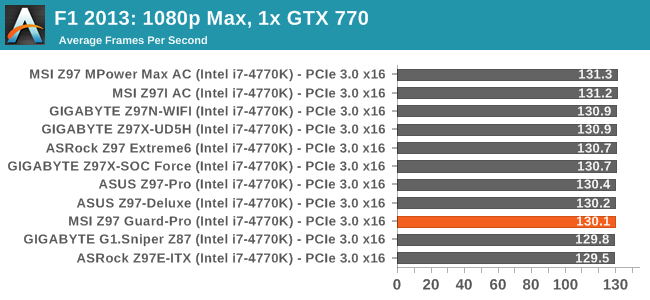
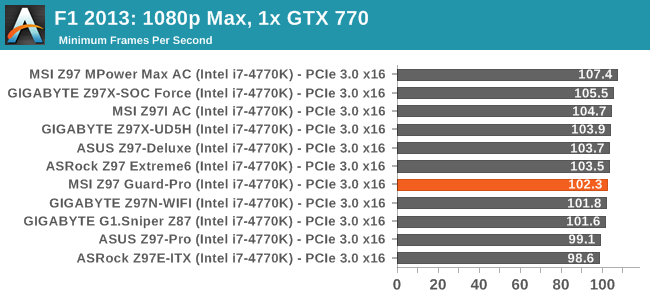
Bioshock Infinite
Bioshock Infinite was Zero Punctuation’s Game of the Year for 2013, uses the Unreal Engine 3, and is designed to scale with both cores and graphical prowess. We test the benchmark using the Adrenaline benchmark tool and the Xtreme (1920x1080, Maximum) performance setting, noting down the average frame rates and the minimum frame rates.
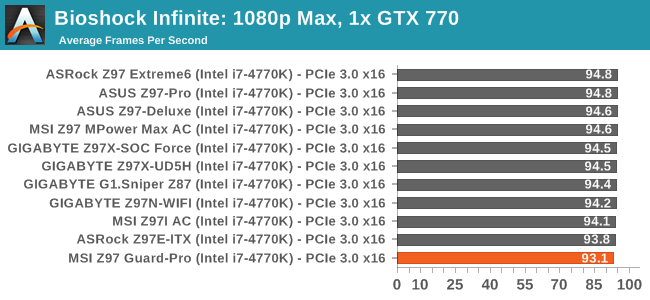

Tomb Raider
The next benchmark in our test is Tomb Raider. Tomb Raider is an AMD optimized game, lauded for its use of TressFX creating dynamic hair to increase the immersion in game. Tomb Raider uses a modified version of the Crystal Engine, and enjoys raw horsepower. We test the benchmark using the Adrenaline benchmark tool and the Xtreme (1920x1080, Maximum) performance setting, noting down the average frame rates and the minimum frame rates.
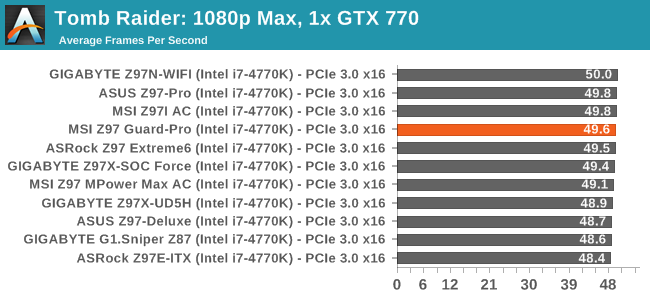
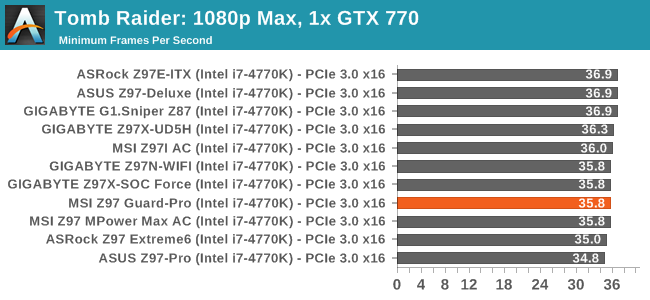
Sleeping Dogs
Sleeping Dogs is a benchmarking wet dream – a highly complex benchmark that can bring the toughest setup and high resolutions down into single figures. Having an extreme SSAO setting can do that, but at the right settings Sleeping Dogs is highly playable and enjoyable. We run the basic benchmark program laid out in the Adrenaline benchmark tool, and the Xtreme (1920x1080, Maximum) performance setting, noting down the average frame rates and the minimum frame rates.
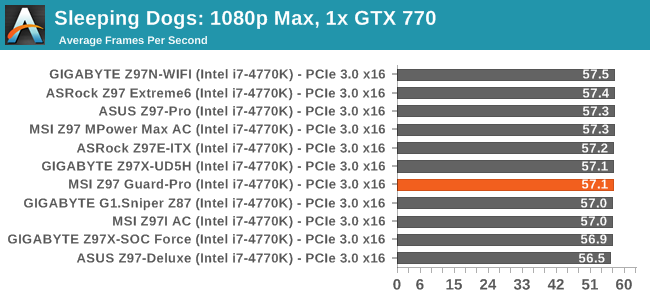
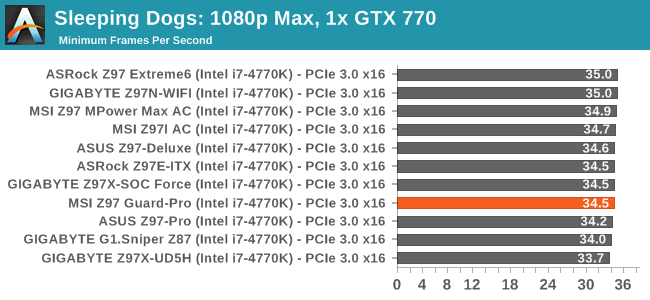
Battlefield 4
The EA/DICE series that has taken countless hours of my life away is back for another iteration, using the Frostbite 3 engine. AMD is also piling its resources into BF4 with the new Mantle API for developers, designed to cut the time required for the CPU to dispatch commands to the graphical sub-system. For our test we use the in-game benchmarking tools and record the frame time for the first ~70 seconds of the Tashgar single player mission, which is an on-rails generation of and rendering of objects and textures. We test at 1920x1080 at Ultra settings.
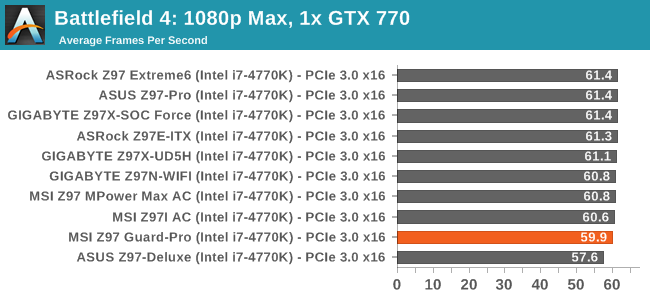
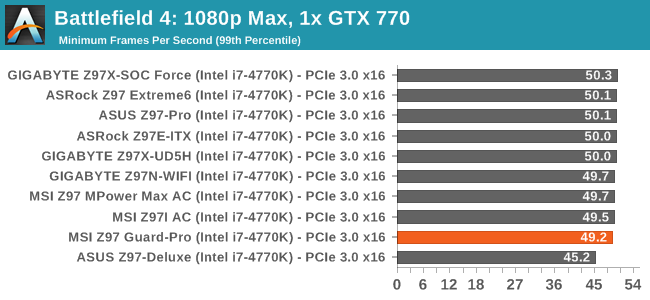


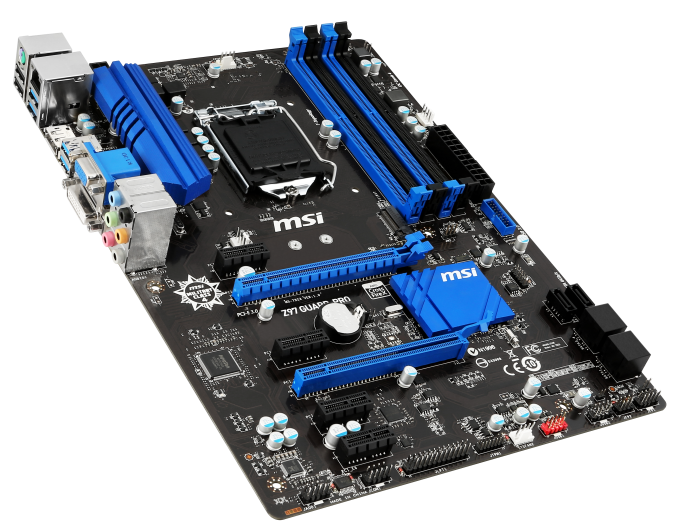
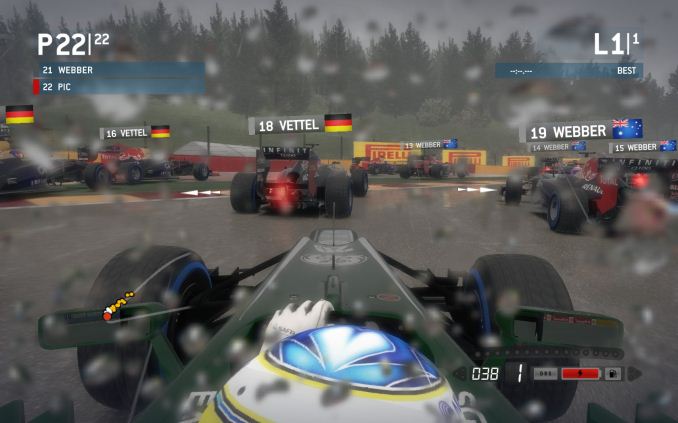












41 Comments
View All Comments
blackmagnum - Wednesday, August 20, 2014 - link
I don't see how this mainboard deserves the name "Pro"; onboard Realtek chips and all.hojnikb - Wednesday, August 20, 2014 - link
Whats wrong with realtek ?Daniel Egger - Wednesday, August 20, 2014 - link
Their LAN chips are completely outdated, the drivers piece-of-crap (also the audio drivers but the hardware is much better nowadays) and often combined with horrible PHYs causing a sub-par networking experience. For anything but most basic networking (where reliability, performance, latency and jitter don't really matter much) the use of Realtek is simply not acceptable.Samus - Wednesday, August 20, 2014 - link
Got any evidence to back that up? Or just making shit up like half the internet? Realtek stuff works fine. The audio codec is average, but it works and the driver support is excellent. However, the network codec is among the best out there (with active driver development) with a good PXE implementation and cross platform support (every linux distribution.)These are software codecs so yes, they use CPU resources (just like the Intel 218) but this isn't 1996 anymore when 56k software modems would slow a PC down. We have more CPU resources available than any program knows what to do with. Complaining about Realtek (or any codec) using CPU resources is like complaining about USB using CPU resources and supporting Firewire over it...it's irrelevant.
If you demand better audio than this board provides, use one of those six PCIe slots with a $30 sound card that'll be superior to just about any onboard audio available...
KAlmquist - Tuesday, August 26, 2014 - link
Four years ago, the Realtek LAN chips had a tendency to switch to 10 Mb/s mode under Linux. At that point, the performance wasn't just a problem if you use a local area network; one of the bug reports was from someone who had a 20 Mb/s connection to his ISP.Maybe things have improved since then, but I'm not inspired to find out. The Intel LAN chips have a list price of $1.72. I'm willing to pay that to get something that I know will work, even if Realtek were willing to give away its chips for free.
Flunk - Wednesday, August 20, 2014 - link
I'd rather have Realtek audio than Via or C-Media. Their codecs tend to be good enough that the quality of sound is determined by the quality of the other audio components on the board.For $110 Realtek LAN is ok, sure I'd rather have Intel but it won't matter for home use.
xenol - Wednesday, August 20, 2014 - link
Audiophiles are even saying that Realtek has caught up in terms of quality (if we use SNR as quality) with at least the ALC889 and ALC1150 chips. Getting anything beyond that is just buying features that flavor the audio.hojnikb - Wednesday, August 20, 2014 - link
Nice board, but a really pointless with pentiumK.spugm1r3 - Wednesday, August 20, 2014 - link
Not really... the Pentium's ability to overclock, and it's single thread performance, put it on par with the 4770K for gaming. Between the processor and the motherboard, you could put a 780ti in this thing and still be under $1000, achieving high end gaming performance for a fraction of the standard price-point for that level of performance, all for eschewing the extra bells and whistles you weren't going to be using anyway.hojnikb - Wednesday, August 20, 2014 - link
And then you wake up in 2014 and realize, that games use more than 2 threads. This thing, even when heavly overclocked, cant touch i5, let alone i7. It could compare to i3 at best.But since you can buy i3 + cheap h81 mobo for less than pentiumK + this mobo it really makes very little sense to go pentiumK route, if you're going budget build.